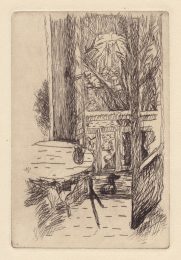

1867-1947
Unlike some artists, French painter and printmaker Pierre Bonnard led a happy and rather normal life as a child. Though, like other artists, it seems this likely influenced his work as he is known for vibrancy of color. In fact, as Bonnard became older, his paintings, primarily landscapes, interiors, nudes and still life increased in their richness of color. Bonnard is known to be “fascinated and delighted” by scenes of daily life around him.
Bonnard followed his father’s advice and attended law school at the University of Paris. However, this was a short lived endeavor as he soon after enrolled in Academie Julian, a liberal art school. It was at Academie Julian where Bonnard met several other artists and formed Les Nabis, a group of Post-Impressionist artists who are credited with setting the pace for fine arts and graphic arts in France during the late 1800s. While the artists in Les Nabis used a variety of media, Bonnard was primarily known for his paintings but also his book illustrations, posters, prints and theatre set designs.
Bonnard’s wife, Marthe, is a frequent subject of his paintings. She is often portrayed nude while in a bathtub or gazing at herself in front of a mirror as well as seated at the kitchen table. Bonnard was known for not painting from life but rather from drawings. Color was so important to Bonnard’s work that while viewing his subject, he often made notes about the colors and referred to these notes while painting from the drawing later on. Bonnard is known for discovering a color after mixing other colors and going back to finished paintings to touch up with the new color. Famously, Bonnard persuaded a friend to distract a guard at a museum which housed a painting. With the guard distracted, Bonnard touched up a painting that had been finished many years before.
Known for working with different levels of perspectives, Bonnard often did not include any real space-defining objects. Instead, objects in his paintings often blended into each other or into the surroundings. A prime example of this is one of his better known works, Dining Room in the Country. In this painting, the chair blends into the wall and the landscape outside blends into itself. The perspective of the work is referred to as a “corner composition” as the viewer of the painting is forced to look out from the corner of the room first taking in the room but eventually and finally gazing upon the landscape outside of the room. While the painting includes a subject, they are clearly not the focus of the painting despite being near to the middle of the painting and rather large.
Bonnard finished his final painting, The Almond Tree, just days before his death. Bonnard was an internationally known artist and the year following his death the Museum of Modern Art in New York City commemorated his birthday with a retrospective. There were other major posthumous exhibits of Bonnard’s work including those in London and again in New York City which celebrated the artist and his impact.